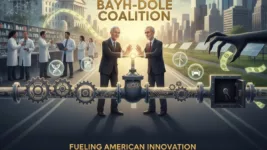For nearly half a century, the United States has relied on a powerful, quiet engine to drive its innovation economy. It’s not in Silicon Valley or on Wall Street, but in the research labs of universities and non-profit institutions across the country. This engine, created by the Bayh-Dole Act of 1980, is the single most successful piece of economic legislation of the past 50 years. It has been responsible for countless life-saving drugs, world-changing technologies and entirely new industries.
Today, that engine is under direct threat from an unexpected source: the U.S. government itself.
A recent proposal from Commerce Secretary Howard Lutnick—suggesting the government should seize half of all patent royalties from federally funded university research—represents a profound misunderstanding of what makes this system work. Standing in firm opposition is the Bayh-Dole Coalition, a group of universities, researchers, patient-advocacy groups and business leaders who understand the stakes. They are fighting to protect a law that has been the cornerstone of American innovation, and their fight is one we should all be paying attention to.
Understanding Bayh-Dole: The Law That Unlocked Innovation
To understand the current battle, one must first understand the world before Bayh-Dole. Prior to 1980, the U.S. government funded billions in research at universities. When that research led to an invention, the patent rights defaulted to the federal government. This sounds reasonable until you look at the results. As detailed in the Bayh-Dole Coalition’s digital library, the government had amassed 28,000 patents by 1980 and had successfully licensed less than 5% of them. The Government was, quite literally, sitting on a treasure trove of innovation and letting it gather dust on a shelf.
The Bayh-Dole Act, a bipartisan effort co-sponsored by Senators Birch Bayh (D-IN) and Bob Dole (R-KS), introduced a simple, revolutionary change. It allowed universities, non-profits and small businesses to retain ownership of the inventions they created with federal funding.
This was not a giveaway. As the Coalition’s technical summary of the Act explains, this ownership came with a critical new responsibility: a mandate to actively pursue commercialization. Universities were now incentivized to file for patents and, most importantly, license those patents to private-sector companies—startups and established firms alike—that could shoulder the risk and cost of turning a raw idea into a marketable product.
The results have been staggering. The impact of Bayh-Dole and technology transfer is undeniable. It has spurred the creation of over 15,000 startup companies, supported millions of jobs and contributed trillions of dollars to the U.S. economy. From the Google search algorithm to life-saving cancer treatments, the fingerprints of Bayh-Dole are everywhere.
A New Threat to a Proven System
This proven system now faces a grave threat from Commerce Secretary Howard Lutnick. His recent proposal suggests that the government should simply “take” 50% of the patent royalties universities earn from these inventions. The rationale seems to be that since the government provided the initial grant funding, it is entitled to a direct cash-back return.
This proposal fundamentally misunderstands the government’s true “return on investment (ROI).” The government’s ROI was never meant to be a simple royalty check. Its return is a stronger economy, the creation of new high-tech jobs, global leadership in science and new medicines that save lives. The Bayh-Dole system was designed to produce those outcomes, which it has done spectacularly.
Lutnick’s plan treats the complex, delicate ecosystem of innovation like a simple ATM, and in doing so, it threatens to break the entire machine.
The Coalition’s Stand: A Unified Voice Against “A Tax That Would Kill Innovation”
The reaction from the innovation community, led by the Bayh-Dole Coalition, has been swift, unified and overwhelmingly negative. As the Coalition’s official statement declared, the proposal “would dismantle the innovation ecosystem” and “undermine U.S. leadership.”
To back this up, the Coalition released survey results from its members—the very people on the front lines of technology transfer. The findings were not just clear; they were practically unanimous. A full 99% of respondents said the proposal would harm their ability to commercialize technology, and 98% said it would make them less likely to license patents to companies.
This isn’t just about money; it’s about incentives. As Joseph Allen, the Coalition’s Executive Director, wrote in a scathing Wall Street Journal op-ed, this proposal is nothing short of “a tax that would kill innovation.”
Why? Because university patent royalties are not “profits.” This money is immediately reinvested into the research enterprise. It pays for the high costs of filing and maintaining patents—a risky, expensive venture that often fails. It funds the technology transfer offices that bridge the gap between labs and industry. Most importantly, it provides seed funding for new, high-risk research, supports graduate students and buys critical lab equipment.
Taking 50% of that money doesn’t just reduce the pie; it shatters the incentive structure. With half the potential return gone, universities will be forced to abandon thousands of promising, early-stage inventions. They will only be able to afford to patent the “safest bets,” letting potentially revolutionary (but less certain) ideas die in the lab. Private companies, seeing the university support system gutted, will be less willing to partner and invest the millions needed to bring a product to market. The pipeline of innovation would slow to a trickle.
Wrapping Up
The Bayh-Dole Act is perhaps the most successful and least-understood law of our time. It transformed the U.S. from a passive funder of research into an active cultivator of innovation, creating a system that is the envy of the world. The Bayh-Dole Coalition is fighting to protect this system not for the sake of universities, but for the sake of the entire nation.
Secretary Lutnick’s proposal is a short-sighted cash grab that would sever the link between public research and public benefit. It would disincentivize discovery, destabilize partnerships and ultimately surrender America’s competitive edge. The government’s role should be to champion and strengthen the Bayh-Dole framework, not dismantle it for a fraction of its true value.






